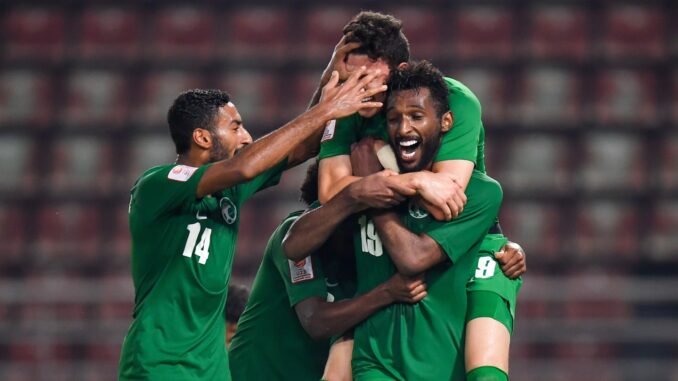
The delayed Tokyo 2020 Olympic Games gets underway this weekend after 18 months of stop-start preparations and its fair share of domestic and international opposition.
Earlier in the week on Thursday, however, the football tournament will try to ignite early interest for the start of the Games, in what is building up to be a credible prospect of medal success for Asian football in general.
Despite only one medal since the 1960’s – South Korea’s triumph over Japan in London 2012’s bronze medal match – 2020 looks the greatest opportunity yet for Asia to better such a feat and challenge for top billing.
Japan, the hosts and arguably the best squad at the tournament are in strong form, as are the aforementioned South Korea, now into their ninth Olympics in a row, while Australia return to their 7th over that time.
But the more interesting prospect comes in the form of Saudi Arabia, after their qualification via the final of the AFC U23 Asian Cup last February.
While their fellow continental qualifiers are regulars at this platform, the Green Falcons are heading to only their third Olympics (following on from 1984 and 1996); a tournament where they’ve spectacularly failed to collect a single point at to date.
They will have to rewrite that record against the very best this time around; drawn once more alongside familiar duo, Brazil and Germany, two sides they faced back in 1984; whilst also drawing 1996 Gold medalists Nigeria.
Back in 1984, a Dunga inspired Brazil plotted a Saudi Arabian downfall on the way to a Gold medal. This time around the new stars of Richarlison or Reinier look to walk in his footsteps and cause yet more Arabian heartache.
Saudi Arabia, outside their general Olympic goals, are in many ways attempting to break a wider hoodoo on the global stage.
Too often do we reminisce a heavy defeat; be it to Germany (again) in 2002, or more recently Russia in 2018, all of which taint the memories of 1994, Saeed Al-Owairan and all that, consigning such pictures to an unrelatable past.
Tides are changing however. Spurred on by their 2018 World Cup qualification, significant focus has been put on developing football throughout the youth pyramid.
Saudi football’s embrace of top level coaching has been paramount in this. Through Bert van Marwijk, Juan Antonio Pizzi and most recently Herve Renard, progress at senior level has gelled a once-regarded team of individuals into one of the most feared national sides in Asian continental football.
While the big coaching names draw the attention to the seniors, a domestic gem continues to rise up at youth level.
Saad Al-Shehri, a young coach who has taken like a sponge to the developing arena around him has been the man tasked to bring through the next generation.
From his early days as Al-Ettifaq head coach, to taking the U19s to a continental final in 2016 and a Round of 16 appearance at the U20 World Cup, Al-Shehri’s pinnacle came as Saudi Arabia qualified for the Olympics, making a continental final yet again, this time at U23 level last year in Thailand.
The 41-year-old coach, despite decent tournament pedigree, has ridden a rocky path in the public eye, fuelled by his notable struggles at domestic level. His style has often been criticised for being too often influenced by those at his disposal rather than following any clear philosophy.
That being said, there are worse things to be associated with given the standard of the Olympic squad at his disposal; Al-Shehri’s clear strength is in development, and this squad is testament to that ability.
This Olympic squad features a heavy bulk of the senior side that qualified for the third round of World Cup qualification a month ago; dynamism from Saud Abdulhamid at full back, the steel and guile of midfield duo Ali Al-Hassan and Sami Al-Najei, and attacking invention of Abdulrahman Ghareeb are all highlights from the U23 contingent.
All have offered glimpses at senior level, but this Olympics provides the opportunity to truly break the barriers ahead of the World Cup qualifiers run-in come September.
Weak areas have been suitably plugged with experience and quality in their overage player selections; captain Salman Al-Faraj, wing back Yasser Al-Shahrani and influential wide man Salem Al-Dawsari are arguably the best three players in Saudi football at present. The full selection on the face of it looks rigid and varied.
There remains doubt, however, crucially in two key areas at either end of the pitch.
Defensively, Saudi Arabia were a fortress in Thailand, having conceded only one goal in normal time throughout their run to the final, built on a dependable and technically proficient centre back partnership of Abdulbasit Hindi and Hassan Al-Tambakti.
The latter was a near miss for player of the tournament, justifiably being fast tracked to the seniors over the last year; an imperious presence moulded with the undoubtable quality of a colossal modern day defender.
Al-Tambakti’s injury on the eve of the tournament then was a hammer blow, coupled with ever lacking domestic minutes (crucially at centre back) for his partner Hindi, puts a question mark against one near certain facet of this team’s identity.
The other area of concern is in attack. A familiar achilles heel for Saudi Arabia, a reliable number nine remains elusive at all age levels. While the seniors under Renard have diversified their options effectively, collecting more goals from wider positions of late, a reliable and effective front man is a thirst left unquenched.
From the breakthroughs of Firas Al-Buraikan and the now growingly infamous Haroune Camera, to recent golden child Abdullah Al-Hamdan, who will likely accommodate top spot come Thursday, the insurmountable pressure for a fresh talented central striker to emerge through to the seniors seems to be a bridge too far for the time being.
Even at youth level, given their progress at the U23s, Saudi Arabia only scored five goals en route to the final, none of which came in the first 45 minutes.
The X-factor ignited by the three overage nominees offers Al-Shehri hope that goals will come a lot easier in Tokyo; yet as with the senior side, an over reliance on giving the ball to Al-Dawsari a fair distance from goal and expecting magic in the every given moment is becoming a little one dimensional, especially when facing the qualities of Brazil and Germany.
One fading concern is that of mentality. Often the stumbling block behind such historic collapses on the global stage, Saudi Arabian football is stronger for it.
This side showed their steely side in impactful, if not exhilarating, performances during preparation, while a preference for a quick counter, of an almost European persuasion, could be easily encouraged against such forward thinking and dominant opposition.
In reality, while Tokyo offers arguably Asia’s best chance of outdoing their bronze of 2012, it undoubtedly focuses hope on primarily the hosts and if not neighbours South Korea.
That being said, Saudi Arabia lurk in the wings not merely here to make up the numbers. If anything looking to make history and register on the board their first Olympic point against some of the tournament’s most successful teams is the perfect setting for a potential upset or two.
Photo: Saudi Arabia Football Federation




